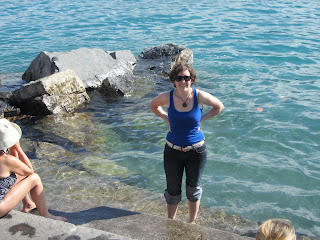A lot has happened since my last entry, but I'll keep this post for all the extracurricular activities.
Immediately following Zurifaecht, Geneva had their own Lake Parade festival. It was great fun, buying costumes and painting faces. I had bought a set of face paints that week and I still feel that it is the best investment I made this summer. It brings out everyone's inner child when they get their faces painted. Funny enough, while we were sitting in the park and I was painting, three young girls came up to me and asked me (of course in French) whether I could also paint their faces. I did, and they were quite pleased. I'm just glad that I didn't have a lineup after that! Needless to say, there was a lot of music and dancing, but thankfully the city wasn't as crowded as Zurich the weekend before.
 |
| All painted for the Geneva lake parade. |
The following weekend was by far the most expensive that I have ever had, but also one of the most memorable ones. I started off by going paragliding in les Saleves just outside Geneva! It was unbelievable and a completely effortless. After a few steps, the parachute inflates and then a few more running leaps and all of a sudden my feet weren't on the ground anymore. Of course, it was done tandem, which probably made it a bit easier as well. Once up in the air, it is a truly amazing and freeing feeling. There is nothing around you, and you can see for kilometers- unbelievable!
 |
| Paragiliding- taken with a GoPro |
I would suggest it to anyone who has the opportunity. The instructor also did some neat air acrobatics in which you turn very sharp corners, which is very neat. Also, the thermal updrafts are quite impressive, as well as the control the instructor had. Apparently it is possible to stay up for several hours if planned properly. Following paragliding, I took the train with friends to Montreux for the Montreux Jazz Festival. It is an impressive event, and there were a lot of big names this year including Leonard Cohen, Diana Krall, Of Monsters and Men, and none other than Prince! I saw James Blake live, which was very interesting. He makes some fascinating electronic music. It was very interesting to see how he can mix and modify the sounds to build up a song. Montreux itself is beautiful too so it was a great experience.
 |
| James Blake at the Montreux Jazz Festival |
This summer has been filled with everything from zombies at the Geneva CineTransat free open air cinema showing of Shawn of the Dead, pub quizzes on Mondays at the Lady Godiva in Geneva, and terrible summer student karaoke. It has all been fantastic. Swimming at la Jonction, where the Rhone and Arve meet is one of the nicest things to do on a sunny lazy Sunday afternoon. Where the rivers meet, the blue Rhone and brown Arve create a very distinct line, which is quite neat. The current in the Rhone is also quite strong, so it is possible to jump in and float down a kilometer or so without any effort. And repeat!
 |
| La Jonction, Geneva |































